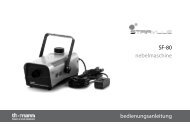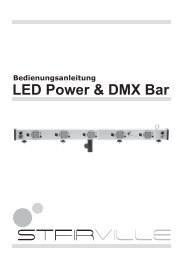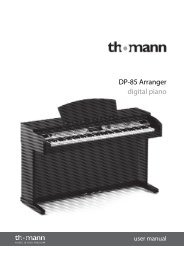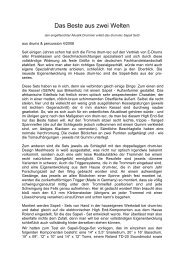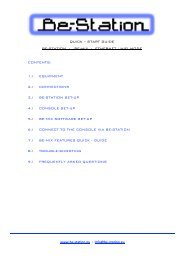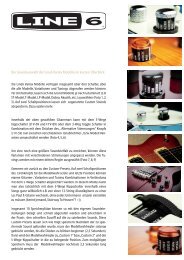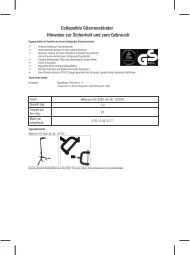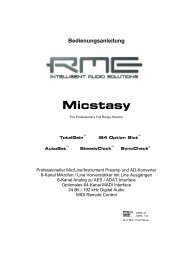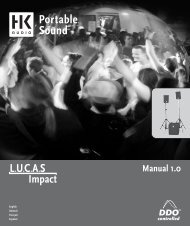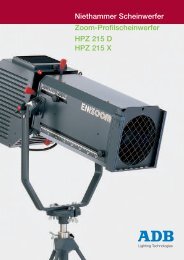You also want an ePaper? Increase the reach of your titles
YUMPU automatically turns print PDFs into web optimized ePapers that Google loves.
chapter 09 ELECTRONIC DRUMS AND BFD2<br />
9:1 Intoduction to using electronic drumkits with BFD2<br />
BFD2 supports the use of electronic drumkits for triggering sounds. Pre-made maps are provided for most kits. However, if you<br />
want to customize the response, or if you need to map a kit that isn’t supported in the provided presets, this section explains how<br />
to best use BFD2’s mapping system for working with electronic kits.<br />
Most triggers/pads on electronic kits are fairly straightforward to map to BFD2’s sounds. However the hihat requires more attention,<br />
as does the snare if you want to utilize positional snare information for switching between the ‘hit’ and ‘half-edge’ hit. If your<br />
kit supports ‘grabbing’ a cymbal trigger to choke it, BFD2 can support this too.<br />
This chapter assumes that you are familiar with using the MIDI view in BFD2. Please make sure you read the previous chapter<br />
fully before this one.<br />
How electronic drumkits work<br />
Electronic drumkits, or ‘e-drums’ usually consist of a number of pads which transmit trigger signals as control voltage over an<br />
audio connection. Additionally, a pedal mechanism that transmits the variable state of the pedal between open and closed, again<br />
using a control voltage over an audio connection.<br />
The audio signals are routed to a converter box, commonly referred to as a ‘drum brain’, which translates audio signals received<br />
from pads into MIDI messages. The brain often also has onboard sounds, which are rather limited due to memory constraints.<br />
Common e-drum systems include D-Drums (formerly made by Clavia), Roland V-Drums, the Yamaha DT series and Alternate<br />
Mode Drumkat. Note that some budget e-drum systems such as the Ion kit do not support variable hihat pedals, instead using a<br />
switch type pedal that simply changes between open and closed states. You cannot utilize variable hihat control with such kits.<br />
Cross-talk between triggers and zones<br />
It s very common to experience cross-talk symptoms when using e-drum systems – when you strike one pad, the resulting vibrations<br />
are picked up by other pads’ sensors. This is often made worse by the fact that most e-drum systems are supplied with a<br />
single-frame mounting system, resulting in less isolation for each pad. In addition to cross-talk between individual pads, substantial<br />
cross-talk also occurs between zones on multi-zone pads.<br />
In practice, this is often not a major problem, as it reflects what would happen with real drumkit to some extent. However, when<br />
using BFD2, it can cause problems:<br />
• Excess disk streaming due to more voices are triggered at once<br />
• Problems when using MIDI learn for note assignments due to multiple notes being sent when striking one pad or zone.<br />
It can be more effective to use manual note assignment when assigning your e-drum system to BFD’s sounds. In order to do this,<br />
you need to know which note is sent out by each pad, or by each part of the pad. Sometimes the brain itself has setup pages<br />
which provide this information, while it can often also be found in the manual. There may be situations, however, when you may<br />
have to examine he MIDI output from the drum brain. BFD2’s MIDI event log allows you to do this.<br />
Double-triggering: setting the Retrigger threshold<br />
Another symptom of cross-talk is ‘double-triggering’ and unwanted choking of sounds, especially when using dual-zone triggers.<br />
Most drum brains have various configuration parameters to get around the cross-talk and double-triggering problem, while BFD2<br />
also contains the Retrigger threshold setting, located in the BFD2 Engine preferences. It allows you to set a length of time after a<br />
received note in which to ignore all notes.<br />
However, it’s always a good idea to eradicate these problems at the source. Please consult your e-drum system documentation<br />
for information on how to minimize the effects of cross-talk with your kit.<br />
Latency<br />
When you’re playing BFD2 with e-drums, it is important to be aware that BFD2 may not respond as quickly as any onboard<br />
sounds in the drum brain. This is due to latency, which is an inherent problem in computer-based digital audio systems.<br />
It is important to remember that latency is NOT caused by BFD2. The sources of latency issues lie elsewhere in your system.<br />
Causes of latency when using BFD2<br />
• Possible additional processing time required in the brain to create the MIDI output, as opposed to triggering the internal sounds.<br />
• Any inherent latency and timing inaccuracies involved with connecting the brain’s MIDI output to the computer’s MIDI interface.<br />
• Any latency involved in getting the data from the MIDI interface to BFD2. USB MIDI interfaces, for example, can have much<br />
larger latency than PCI or serial interfaces).<br />
• Audio interface latency/buffer size. Smaller buffer sizes result in lower latencies. However, they also require more CPU power<br />
and well-engineered audio interface hardware and drivers.<br />
1



